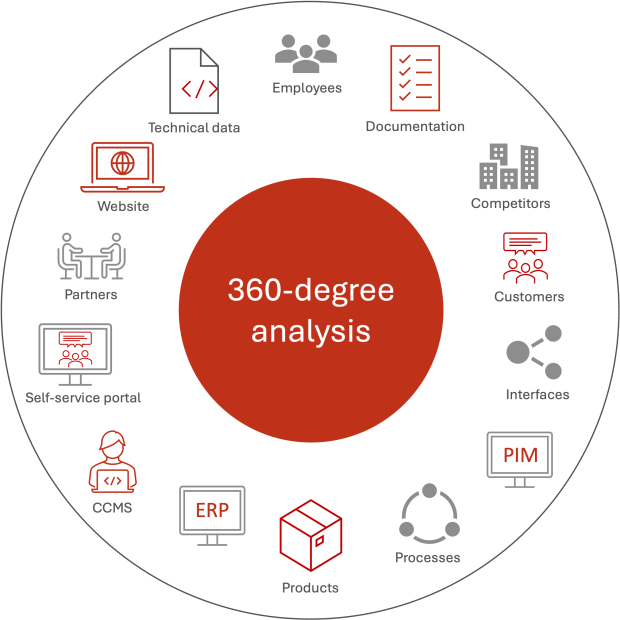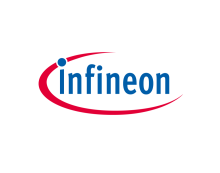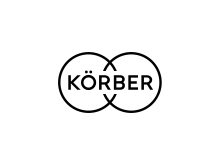360-degree analysis for content processes and systems
Gain a clear perspective on existing processes
The 360-degree analysis holistically examines your processes in technical communication and product data management – from the perspectives of employees, management, customers, and external partners. The result is a connected, realistic overall picture that reveals optimization potential often overlooked in day-to-day operations.
Whether you are preparing to digitalize enterprise content or aiming to optimize current processes – the 360-degree analysis provides a sound assessment, uncovers weak points, and highlights concrete actions. For greater transparency and better decision-making.
In technical communication, where many departments, tools, and requirements intersect, the 360-degree analysis offers valuable guidance and cross-functional insights. It supports the strategic preparation and successful implementation of digitalization initiatives, such as introducing a component content management system (CCMS), building a self-service platform for customers, using AI in customer service, and creating digital twins.
Why a 360-degree analysis is worth it
Renew or enhance processes
Many companies rely on established processes that work well in the daily routines, but they often overlook untapped potential or necessary adjustments due to market changes. A 360-degree analysis can systematically identify workflow breaks and bottlenecks, duplicated efforts, and unnecessary complexity – caused, for example, by siloed systems or inefficient workflows. This makes it easier to streamline processes, integrate systems better, and boost satisfaction for everyone involved.
Prepare for digitization or automation
Companies that aim to digitalize or automate processes need a clear view of their current state. A 360-degree analysis provides the necessary transparency and a solid foundation for making informed decisions – including selecting appropriate tools.
Reorganization or company growth
Growth and change bring new demands on processes. A 360-degree analysis helps standardize structures, clarify interfaces, and make workflows scalable.
New legal or regulatory requirements
New regulations – such as those regarding data protection or product identification – require documented and compliant processes. A 360-degree analysis can identify gaps and support efforts to ensure regulatory compliance.
Improve customer satisfaction and service quality
Slow response times and a lack of transparency reduce customer satisfaction. The 360-degree analysis brings in the customer perspective and pinpoints pain points in your processes. It also includes a review of competitors’ information offerings for comparison.
Make work easier – make employees happier
Unclear responsibilities and inefficient routines can lead to frustration. The 360-degree analysis reveals opportunities for improvement and helps streamline processes.
Prepare for certifications or audits
Whether it’s ISO 9001, ISO 27001, environmental management or ESG – certifications require clarity and robust process documentation. A 360-degree analysis provides the right foundation by clearly documenting processes and making them ready for improvement.
We carry out the 360-degree and process analysis for you. This is how we work
Your contacts
for the 360-degree analysis
Our customers
We carry out the 360-degree and process analysis for you. This is how we work
- Internal perspectives. We gather insights from employees and management. Through interviews, surveys, and workshops, we bring together operational and strategic viewpoints.
- External perspectives. We analyze how your processes are perceived – by customers, suppliers, partners, and competitors. Surveys, interviews, and competitor benchmarks reveal opportunities for improvements in areas such as service quality, interfaces, and technical content delivery.
- Analysis of data, content, and systems. We evaluate content, data, processes, and interfaces across systems, including content management systems, delivery platforms, customer portals, product lifecycle management (PLM), product information management (PIM), and ERP systems.
- Considering the bigger picture. We integrate organizational, technological, and compliance-related factors from the start. This ensures that all recommendations are realistic, future-proof, and compliant – even with industry-specific requirements.
Learn more about the 360-degree process analysis in our FAQs.
FAQs – Frequently asked questions about the 360-degree process analysis
What is a 360-degree analysis?
It is an in-depth form of process analysis. Rather than examining workflows only internally, it takes a holistic approach, considering the perspectives of employees, management, customers, and external stakeholders. It also includes an analysis of data and content. This creates a comprehensive overview that pinpoints weaknesses and enables targeted improvements – especially in technical communication and product data management.
What is the difference between a 360-degree analysis and a classic process analysis?
A classic process analysis usually focuses on internal workflows – assessing how processes function, identifying issues, and suggesting improvements. A 360-degree analysis goes further by adding external viewpoints, data analysis, content analysis, and cross-departmental context, making it ideal for complex, cross-functional, or strategic initiatives.
How does a typical 360-degree analysis work?
- Define goals and approach. The analysis typically supports a transformation process. First, goals and methods are clarified.
- Capture current state. The current state of processes, content, and tools is assessed through interviews, workshops, surveys, and observations, integrating all perspectives.
- Evaluate and make recommendations. We systematically analyze the results, often with the support of AI, and derive concrete, goal-oriented recommendations.
- Support implementation. Upon request, we provide ongoing support to implement the recommended measures.
When is a 360-degree analysis useful?
It is especially helpful during times of change, such as reorganizations, digital transformation, modernization, rapid growth, or the launch of new products. It's also valuable when friction between departments begins to affect everyday work.
In technical communication, the analysis uncovers weaknesses in how information is created and delivered to both employees and customers. The goal is to make processes more efficient, scalable, and sustainable. This includes reviewing existing workflows, determining actions, and evaluating current systems for content creation and delivery, focusing on modularization, reuse, and modern content strategies.
Which methods are used for process analysis?
The following methods are used to analyze and optimize processes:
- Interviews. One-on-one or group interviews with all stakeholders involved in the process chain.
- Observations. Accompanying specific work steps during daily operations to gain an external perspective on the workflows.
- Surveys and questionnaires. Data collection by surveying selected target groups on specific topics.
- Workshops. Joint analysis of current processes and development of target scenarios.
- Document analysis. Reviewing existing process documentation, internal documents, technical documentation, marketing materials, editorial guidelines, and so on.
- System analysis. Evaluation of the tools and systems in use regarding usability, interfaces, and future viability.
- Maturity assessments. Evaluation of the current organization, structures, processes, and content using a standardized scale.
How do I create a process analysis?
A process analysis is typically created in several steps:
- Define the goal. What should the analysis achieve?
- Select the process. Which process should be analyzed? Examples include document approval process and translation management.
- Collect information. Use interviews, observations, workshops, document analysis, etc.
- Model the current process. Create a visual representation of the current workflow that includes all stakeholders, tools, and interfaces.
- Identify problems and potential improvements. Where do bottlenecks, media disruptions, or unclear responsibilities occur?
- Design the target process. Develop an optimized future process with clear responsibilities and efficient workflows.
- Derive action steps. Define concrete implementation measures, such as tool adjustments, role clarification, and training.
Which tools are used for process analysis?
Various tools can be used for analyzing and modeling processes, depending on the objective:
- Mind-mapping tools, such as MindManager, are used for brainstorming, workshop documentation, and collaborative idea collection.
- Process modeling and diagramming tools, such as Microsoft Visio or Signavio, are used to visualize current and future processes.
- Table-based tools, such as Excel, are used for recording process data, roles, requirements, and improvement opportunities in tabular form.
- Agile project management and backlog tools, such as JIRA or Azure DevOps.
- Presentation tools, such as PowerPoint, are also used.











